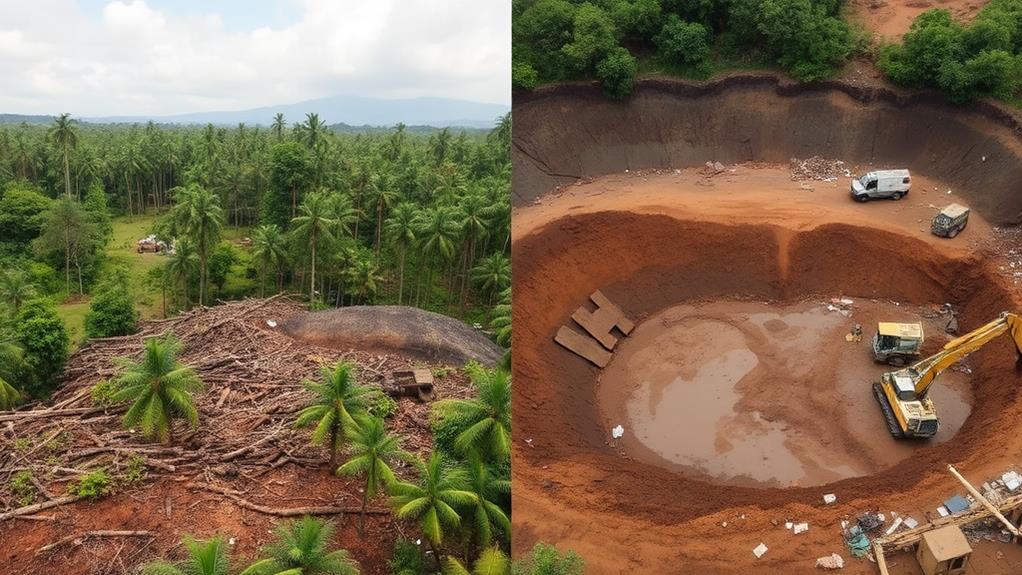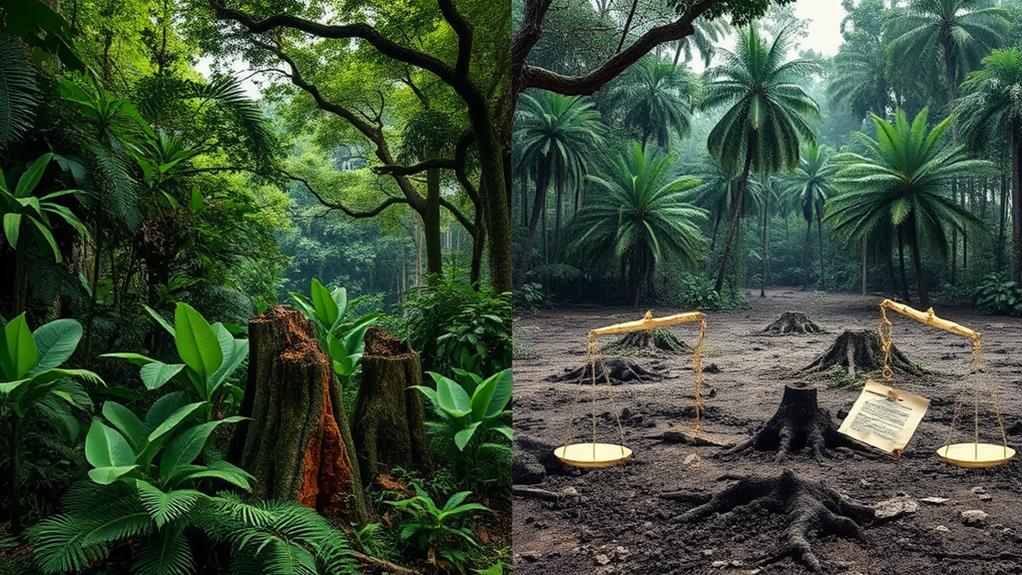Illegal logging and mining in the Philippines are serious problems. These activities harm ecosystems and hurt local communities. Illegal logging destroys forests, which are home to many species. For example, cutting down trees can lead to the loss of habitats for animals like the Philippine eagle.
Mining operations can also threaten Indigenous cultures. When land is taken for mining, it can disrupt the way of life for these communities.
Weak law enforcement allows illegal activities to continue. Corruption among officials makes it hard to stop these practices. As a result, communities that depend on forests and minerals for their livelihoods face economic struggles.
Existing environmental laws are not always enforced. Protected areas are often exploited, raising concerns about future sustainability.
Local communities are working to protect their environment. They advocate for stronger regulations and awareness about the importance of conservation.
However, without strict rules, their cultural heritage and ways of life remain at risk. Efforts are being made to combat these challenges, but much more needs to be done to ensure a sustainable future for both people and nature.
Overview of Illegal Logging and Mining

Illegal logging and mining in the Philippines are serious problems for the environment and local communities. Between 1934 and 1988, about 9.8 million hectares of forest were lost, mostly due to illegal logging. This loss harms biodiversity, which means many plants and animals are at risk because their habitats are destroyed.
Additionally, over 28,000 hectares in Palawan are now used for mining, raising concerns about more deforestation and damage to important Indigenous sites.
People living near the Sierra Madre range rely on these forests for their livelihoods. Illegal activities make them more vulnerable as they struggle to find resources.
The situation worsens due to corruption and poor law enforcement, which allow illegal logging to continue without consequences. Even though the government banned new small-scale mining in 2008, large-scale mining still occurs, which threatens forest management and Protected Areas.
The impact of illegal logging and mining is severe. It affects both the land and the future of communities that depend on these natural resources.
Addressing these issues is essential to safeguard the environment and support local livelihoods.
Environmental and Cultural Impacts
Logging and mining in the Philippines cause serious environmental and cultural problems. Illegal logging in places like Palawan harms ecosystems and threatens many species. This loss of biodiversity impacts Indigenous communities who depend on these forests for their farming and spiritual practices.
Increased mining near Mount Domadoway threatens cultural traditions and ancestral lands. This raises concerns about Indigenous rights and how well the environment is protected. Sacred forests that are important for many local tribes are being destroyed, which puts endangered species, like the Philippine eagle, at risk.
Places like Mount Busa are culturally significant, and their disappearance harms the livelihoods and spiritual practices of local tribes.
It's essential to understand these connected issues and advocate for both environmental protection and the preservation of cultural heritage amid illegal logging and mining activities.
Legal Frameworks and Regulations

In the Philippines, laws exist to protect the environment from logging and mining, but enforcement is often weak. The Strategic Environmental Plan (SEP) Act of 1992 created a logging ban in Palawan and set up Protected Areas to help maintain forest cover. Despite this, illegal logging still occurs, which harms the environment.
The Mining Act and the Wildlife Resources Conservation and Protection Act outline rules for mining and protecting wildlife. However, actual enforcement of these laws is a major problem. There are controlled use zones where mineral extraction is allowed, but only if it meets strict guidelines checked by the Palawan Council for Sustainable Development (PCSD).
The situation has worsened since President Duterte lifted the mining moratorium, raising concerns about increased exploitation in protected areas.
Penalties for breaking environmental laws include large fines and prison time, but these punishments are rarely enforced. This lack of enforcement leads to ongoing biodiversity loss and ecosystem damage.
To better protect the Philippines' natural resources, there needs to be a stronger commitment to enforcing laws and reassessing current policies. Everyone can advocate for better protections and hold officials accountable.
Socioeconomic Challenges for Communities
Environmental laws are difficult to enforce, and this affects local communities that rely on forests for their income. Illegal logging and mining threaten traditional activities like fishing and farming, leading to loss of income and pushing many residents toward illegal work for survival.
The socioeconomic effects are significant. For example, a petition against mining in Palawan gathered over 10 million signatures, showing that many people oppose harmful industries.
| Socioeconomic Impact | Description |
|---|---|
| Loss of Livelihoods | Traditional jobs are disrupted, making it hard to earn money. |
| Biodiversity Threat | Damage to ecosystems harms food sources and wildlife. |
| Cultural Heritage Erosion | Practices linked to the forests are at risk of disappearing. |
As illegal activities continue, local communities struggle to protect their cultural heritage and deal with the effects of environmental damage. It is a challenging situation that threatens their way of life.
How Does Illegal Logging and Mining Impact Environmental Law Enforcement in the Philippines?
Illegal logging and mining have a detrimental impact on environmental law enforcement in the Philippines. These activities contribute to deforestation, soil erosion, and biodiversity loss, making it challenging for environmental law enforcement philippines to regulate and protect natural resources. The government faces significant challenges in combating these illegal practices.
Conservation Efforts and Initiatives

Conservation efforts in the Philippines are increasing to protect the country's biodiversity. The National Greening Programme aims to plant 1.5 billion trees over 1.5 million hectares by 2028. This reforestation project tackles the problems of deforestation and illegal logging. Laws like the Expanded National Integrated Protected Areas System (E-NIPAS) protect important forests and ban harmful activities.
Local communities are actively participating in conservation. Tribal members take part in biodiversity assessments, which empowers them and uses their traditional knowledge to help the environment.
Organizations such as the Haribon Foundation lead reforestation projects in the Sierra Madre, showing how cooperation between former illegal loggers and conservationists can be effective.
International partnerships and campaigns like #SaveSierraMadre raise awareness about sustainable development. By working together, we can reduce the environmental damage caused by illegal activities and protect the Philippines' biodiversity for future generations.
Future Directions for Sustainability
Addressing illegal logging and mining in the Philippines requires a combined effort of strict law enforcement and community involvement. Simply enforcing penalties of up to 5 million pesos and 6 to 12 years in prison isn't sufficient.
Engaging local communities in sustainable practices can lead to better outcomes, especially in regions like Mount Busa and the Sierra Madre.
Promoting alternative livelihoods, such as eco-tourism and sustainable forestry, can help reduce reliance on forest resources. This change not only tackles economic reasons behind illegal logging but also gives communities control over their natural resources.
Partnering with organizations like DGB Group is crucial for expanding reforestation projects. These efforts will restore damaged areas and protect biodiversity.
Public awareness campaigns are important for education on sustainable sourcing. Teaching people about the benefits of choosing responsibly sourced timber can build a sense of environmental responsibility.
By increasing community engagement and promoting sustainable practices, we can work toward a more sustainable future for the Philippines. This will help ensure that the country's rich biodiversity is protected for future generations.
Questions and Answers
What Are the Problems With Illegal Logging in the Philippines?
Illegal logging leads to forest degradation and biodiversity loss. This means that forests are damaged and many plant and animal species are disappearing. For example, in the Philippines, illegal logging has resulted in fewer trees and habitats for wildlife, which can disrupt the ecosystem.
Enforcement challenges and ineffective government policies make the situation worse. Many local communities depend on forests for their livelihoods, but when logging is not controlled, it threatens their way of life. For instance, people may lose jobs related to sustainable forest use or face increased flooding due to fewer trees.
To address these problems, it is important to promote economic incentives for communities. This can include providing rewards for protecting forests rather than cutting them down. Increasing environmental awareness can help people understand the importance of forests. Lastly, respecting indigenous rights ensures that local communities have a voice in decisions that affect their land, which can lead to better protection of the forests.
What Are the Problems With Illegal Mining in the Philippines?
Illegal mining in the Philippines has serious negative effects. It causes economic problems, as communities lose potential income from legal mining. It harms the environment, leading to soil and water pollution. Biodiversity is affected, as habitats for plants and animals are destroyed.
Additionally, illegal mining leads to community conflicts. Disputes arise between illegal miners and local residents. Health risks are also a concern, as workers may be exposed to harmful chemicals. Land disputes occur when illegal miners occupy areas without permission.
Moreover, regulatory challenges make the situation worse. Weak enforcement allows illegal trade to thrive. This undermines efforts to reduce poverty in affected areas, leaving communities with fewer resources and opportunities.
What Are the Bad Effects of Mining and Illegal Logging Activities in the Philippines?
Mining and illegal logging harm ecosystems. They cause biodiversity loss and lead to the extinction of wildlife. For example, when forests are cut down, animals lose their homes and can't survive.
These activities also result in soil erosion. This means that the top layer of soil is washed away, making it hard for plants to grow. Additionally, water pollution occurs when chemicals from mining seep into rivers and streams, harming fish and other aquatic life.
Furthermore, community displacement happens when people are forced to leave their homes. This can lead to economic instability as families lose their jobs and livelihoods. The health risks increase too, as polluted water and air can cause serious diseases.
What Are the Problems With Deforestation in the Philippines?
Deforestation in the Philippines leads to biodiversity loss, which means many plants and animals can disappear forever. For example, when forests are cut down, species like the Philippine Eagle lose their homes. It also increases carbon emissions; trees absorb carbon dioxide, so without them, more greenhouse gases enter the atmosphere, contributing to climate change.
Another problem is soil erosion. Without trees to hold the soil in place, heavy rains can wash away the topsoil, making it harder for crops to grow. This also deteriorates water quality because the soil and pollutants can run into rivers and lakes, harming fish and other wildlife.
Deforestation threatens indigenous rights. Many indigenous people rely on forests for their culture and livelihood. When forests are destroyed, their way of life is at risk. Additionally, it causes habitat destruction. Animals like the Tarsier lose their homes, which can lead to population declines.
Moreover, it drives climate change. As more trees are cut down, the planet gets warmer. This can lead to more severe weather events, like typhoons. Finally, deforestation displaces communities, forcing people to leave their homes and affecting local economies, as they rely on forest resources for their livelihoods.